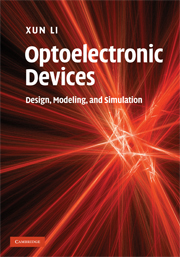Book contents
- Frontmatter
- Contents
- Preface
- 1 Introduction
- 2 Optical models
- 3 Material model I: Semiconductor band structures
- 4 Material model II: Optical gain
- 5 Carrier transport and thermal diffusion models
- 6 Solution techniques for optical equations
- 7 Solution techniques for material gain equations
- 8 Solution techniques for carrier transport and thermal diffusion equations
- 9 Numerical analysis of device performance
- 10 Design and modeling examples of semiconductor laser diodes
- 11 Design and modeling examples of other solitary optoelectronic devices
- 12 Design and modeling examples of integrated optoelectronic devices
- Appendices
- Index
1 - Introduction
Published online by Cambridge University Press: 09 October 2009
- Frontmatter
- Contents
- Preface
- 1 Introduction
- 2 Optical models
- 3 Material model I: Semiconductor band structures
- 4 Material model II: Optical gain
- 5 Carrier transport and thermal diffusion models
- 6 Solution techniques for optical equations
- 7 Solution techniques for material gain equations
- 8 Solution techniques for carrier transport and thermal diffusion equations
- 9 Numerical analysis of device performance
- 10 Design and modeling examples of semiconductor laser diodes
- 11 Design and modeling examples of other solitary optoelectronic devices
- 12 Design and modeling examples of integrated optoelectronic devices
- Appendices
- Index
Summary
The underlying physics in device operation
Figure 1.1 shows the major physical processes and their linkages in the operation of optoelectronic devices.
To capture these physical processes, we need the following models and knowledge:
a model that describes wave propagation along the device waveguide (electromagnetic wave theory);
a model that describes the optical properties of the device material platform (semiconductor physics);
a model that describes carrier transport inside the device (quasi-electrostatic theory);
a model that describes thermal diffusion inside the device (thermal diffusion theory).
Therefore, the above four aspects should be included in any model established for simulation of optoelectronic devices.
Modeling and simulation methodologies
There are two major approaches in device modeling and simulation.
(1) Physics modeling: a direct approach based on the first principle physics-based model.
The required governing equations in the preceding four aspects are all derived from first principles, such as the Maxwell equations (including electromagnetic wave theory for the optical field distribution and quasi-electrostatic theory for the carrier transport), the Schrödinger equation (for the semiconductor band structure), the Heisenberg equation (for the gain and refractive index change), and the thermal diffusion equation (for the temperature distribution).
This model gives the physical description of what exactly happens inside the device and is capable of providing predictions on device performance in every aspect, once the device building material constants, the structural geometrical sizes, and the operating conditions are all given.
This approach is usually adopted by device designers who work on developing devices themselves.
- Type
- Chapter
- Information
- Optoelectronic DevicesDesign, Modeling, and Simulation, pp. 1 - 5Publisher: Cambridge University PressPrint publication year: 2009



